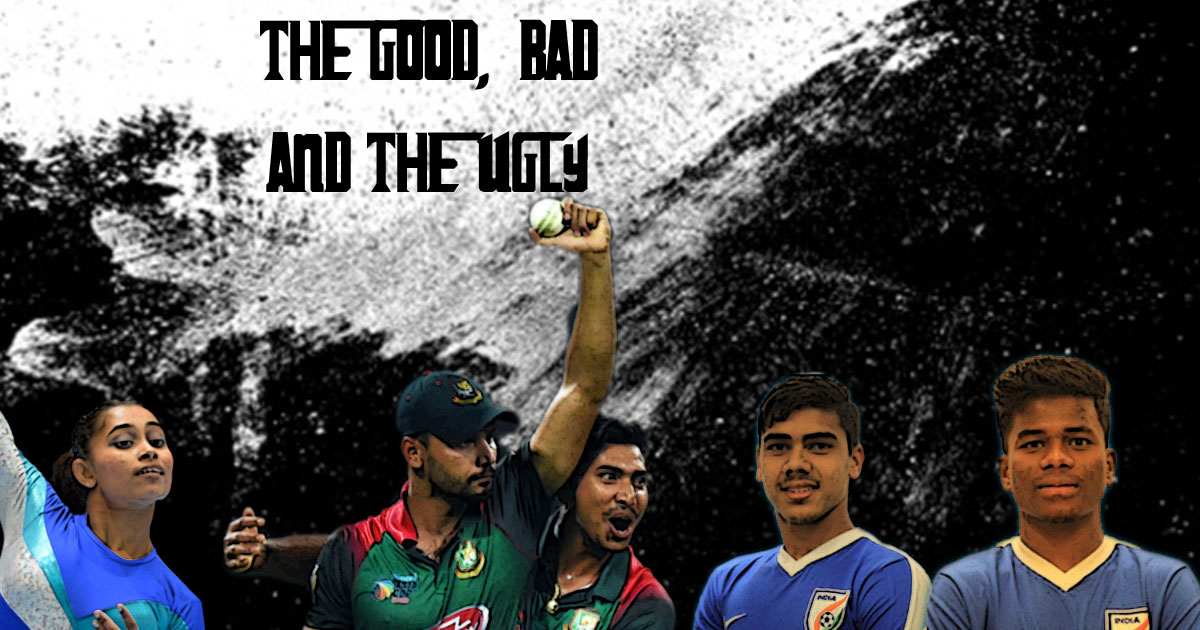The Good, Bad & Ugly ft. India’s U-16 football team, Bangladesh and BCCI

Sportcafe
From India's U-16 football team performing well in the AFC Cup to India finding a fitting rival in Bangladesh, the sporting world gave us moments to rejoice this week. However, BCCI's non-cooperation with WADA, ISL club's sheer unprofessionalism and SAI's irrelevant trials showed us the other side.
GOOD
The biggest news for a true Indian football fan this week wouldn’t have been the much-awaited commencement of the India Super League (ISL), but the qualification of the Indian U-16 colts for the quarter-finals of the AFC Cup after 16 long years. And the one thing more exciting than their qualification is the way they have done it. Under Bibiano Fernandes’ management, the team hasn’t conceded a single goal playing against Vietnam, Indonesia, or Iran in the group stage. The last time India had qualified from the group stage was back in 2002 and it was four
While India and Bangladesh’s rivalry in cricket has fast gained prominence amidst the fading India-Pakistan one thanks to BCCI, one cannot deny the fact that India
BAD
India’s astronomical population, which lives and breathes cricket, has given the Board of Control for Cricket (BCCI) a jackpot, making the body omnipotent for life. Their wealth and influence have reached to such an extent today that they call the most crucial shots in the sport of cricket. However, their supremacy was bearable by the world body, International Cricket Council (ICC), and other country associations only until BCCI’s decisions didn’t affect them as a whole. BCCI’s year-long struggle with WADA (World Anti-Doping Agency), where numerous efforts have been made to make BCCI follow WADA’s protocols and reach a middle ground with the National Anti-Doping Agency (NADA), has not yet been able to get cricket into Olympics. BCCI, who has their own agency to deal with it, has been too stubborn to bow down and now the world drug control body has warned that they would consider ICC non-compliant if they didn’t sort out the differences of BCCI. The Indian cricket body is exploiting its infinite power here and although a possibility of complete alienation from other cricket bodies looks improbable, they shouldn’t push the limits. ICC CEO David Richardson has now accused BCCI of blocking Cricket’s Olympic dream.
One day before the ISL was supposed to start, news broke out that as many as five ISL clubs had failed the AFC licensing criteria. Given the richest football league in the country and the millions spent on getting foreign recruitments and infrastructure, it was a shocking revelation. And given that the licensing criteria are as basic as proper documenting of transfers and players, an appointment of a head coach, medic, financing officer and more, the incident is all the more embarrassing for it hints at a complete lack of professionalism by the clubs. The five clubs failing to do that are Kerala Blasters, Mumbai City FC, FC Pune City, Delhi Dynamos, and Jamshedpur FC. Apart from Jamshedpur, all the others have been at the highest level for years and were undoubtedly well versed in the necessary AFC norms. And the fact that the other five franchises - Chennaiyin FC, Bengaluru FC, FC Goa, ATK, and NorthEast United – have cleared it, also reflects badly on the others. The issue rightly shows what is at the crux of the development of Indian football today and we hope they act upon it faster as both the aspects are interlinked.
UGLY
Imagine if the controversial and inconsequential Sri Lanka series at the 2017 end had been scrapped, and India had enough time to prepare for the South Africa series. But, upon
There is no middle ground for India’s Sports Authority of India it seems. After they were in everyone’s good books last week for introducing life management classes for its athletes that would help them to manage stress, finance, and other aspects of a sportsman’s life, this week they have been criticized heavily for irrelevant selection criteria for the Indian gymnasts. In the trials for the Artistic World Championship SAI’s directives have asked athletes to perform the all-rounder routine instead of their individual events for selection, a process that the upcoming world cups will follow. And it has left the gymnasts baffled who were unprepared and uninformed about it. Despite a team event needing three men and three women to perform, SAI would select only four athletes, which makes it incomprehensible. To further make things worse when asked Riyaz Ahmed Bhati about it, who has recently replaced Kaushik Bediwala in SAI’s selection panel, he sounded equally befuddled. Also the vice-president of Gymnastic Federation of India (GFI), Bhati has revealed that he was selected in the last moment and stated that the new selection criteria have left the gymnasts with little time to prepare.
